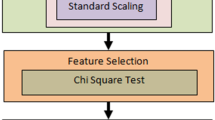Abstract
Android has become a leader in market share of mobile operating systems. In addition, it has attracted interest of attackers greater than other running systems. As a result, Android malware is developing rapidly. In this study, the foremost focal point is on inspecting and detecting botnets that are particular type of malwares. To analyze android botnet detection, it is appropriate to pick out and analyze elements which are enormously applicable or most influential to the botnet detection. This technique typically named variable determination is corresponds to determine a subset of complete recorded variables which presents favorable predictions capability. In this research work, architecture based totally upon adaptive neuro-fuzzy inference system (ANFIS) is used to model complex systems in function approximation and regression. ANFIS community is employed to operate variable selection for identifying that how the botnet have an effect on the android. After deciding on the two most influential parameters, the ANFIS is utilized to create a machine for android botnet detection on the foundation of the chosen parameters.








Similar content being viewed by others
References
Darkreading (2013) 150% increase in mobile online shopping black Friday through cyber Monday. Available http://www.darkreading.com/mobile/150-increase-in-mobile-online-shopping-b/240164440. Accessed 1 June 2014
CNET (2014) Android nabs 53% of US smartphone activations in Q1. Available http://www.cnet.com/news/android-nabs-53-percent-of-us-smartphone-activations-in-q1. Accessed 1 June 2014
Techcrunch (2013) Android accounted for 79% of all mobile malware in 2012, 96% in Q4 alone, says f-secure. Available http://techcrunch.com/2013/03/07/f-secure-android-accounted-for-79-of-all-mobile-malware-in-2012-96-in-q4-alone/. Accessed 1 Jan 2013
F-Secure (2014) Q1 2014 mobile threat report. Available http://www.f-secure.com/weblog/archives/00002699.html. Accessed 1 June 2014
F-Secure (2014) Backdoor:Android/Dendroid.A. Available http://www.f-secure.com/v-descs/backdoor_android_dendroid_a.shtml. Accessed 1 June 2014
Symantec (2013) Android madware and malware trends. Available http://www.symantec.com/connect/blogs/android-madware-and-malware-trends. Accessed 1 June 2014
Castellano G, Fanelli AM (2000) Variable selection using neural-network models. Neurocomputing 31(1–4):1–13
Dieterle F, Busche S, Gauglitz G (2003) Growing neural networks for a multivariate calibration and variable selection of time-resolved measurements. Anal Chim Acta 490(1–2):71–83
Cibas T, Soulié FF, Gallinari P, Raudys S (1996) Variable selection with neural networks. Neurocomputing 12(2–3):223–248
Andersson FO, Åberg M, Jacobsson SP (2000) Algorithmic approaches for studies of variable influence, contribution and selection in neural networks. Chemom Intell Lab Syst 51(1):61–72
Sofge D (2002) Using genetic algorithm based variable selection to improve neural network models for real-world systems. In: Proceedings of the international conference on machine learning and applications, Las Vegas, pp 16–19
Chan KY, Ling SH, Dillon TS, Nguyen HT (2011) Diagnosis of hypoglycemic episodes using a neural network based rule discovery system. Expert Syst Appl 38(8):9799–9808
Kwong CK, Wong TC, Chan KY (2009) A methodology of generating customer satisfaction models for new product development using a neuro-fuzzy approach. Expert Syst Appl 36(8):11262–11270
Jang JSR (1993) ANFIS: adaptive-network-based fuzzy inference system. IEEE Trans Syst Man Cybern 23(3):665–685
Sarat CN, Bijan BM (2019) A chemical-reaction-optimization-based neuro-fuzzy hybrid network for stock closing price prediction. Financ Innov 5:38
Elaheh Y, Mehrbakhsh N, Liyana S, Shahla A, Othman I (2019) Development of a SaaS adoption decision-making model using a new hybrid MCDM approach. Int J Inf Technol Decis Mak 18(06):1845–1874
Petković D, Issa M, Pavlović ND, Pavlović NT, Zentner L (2012) Adaptive neuro-fuzzy estimation of conductive silicone rubber mechanical properties. Expert Syst Appl 39(10):9477–9482
Petković D, Ćojbašić Ž (2012) Adaptive neuro-fuzzy estimation of autonomic nervous system parameters effect on heart rate variability. Neural Comput Appl 21(8):2065–2070
Shariati M, Mafipour MS, Mehrabi P, Shariati A, Toghroli A, Trung NT, Salih MN (2020) A novel approach to predict shear strength of tilted angle connectors using artificial intelligence techniques. Eng Comput, 1–21
Shariati M, Mafipour MS, Haido JH, Yousif ST, Toghroli A, Trung NT, Shariati A (2020) Identification of the most influencing parameters on the properties of corroded concrete beams using an adaptive neuro-fuzzy inference system (ANFIS). Steel Compos Struct 34(1):155
Toghroli A, Mohammadhassani M, Suhatril M, Shariati M, Ibrahim Z (2014) Prediction of shear capacity of channel shear connectors using the ANFIS model. Steel Compos Struct 17(5):623–639
Shariati M, Azar SM, Arjomand MA, Tehrani HS, Daei M, Safa M (2020) Evaluating the impacts of using piles and geosynthetics in reducing the settlement of fine-grained soils under static load. Geomech Eng 20(2):87
Armaghani DJ, Mirzaei F, Shariati M, Trung NT, Shariati M, Trnavac D (2020) Hybrid ANN-based techniques in predicting cohesion of sandy-soil combined with fiber. Geomech Eng 20(3):191
Areed FG, Haikal AY, Mohammed RH (2010) Adaptive neuro-fuzzy control of an induction motor. Ain Shams Eng J 1(1):71–78
Petković D, Issa M, Pavlović ND, Zentner L, Ćojbašić Ž (2012) Adaptive neuro fuzzy controller for adaptive compliant robotic gripper. Expert Syst Appl 39(18):13295–13304
Tian L, Collins C (2005) Adaptive neuro-fuzzy control of a flexible manipulator. Mechatronics 15(10):1305–1320
Aldair AA, Wang WJ (2011) Design an intelligent controller for full vehicle nonlinear active suspension systems. Int J Smart Sensing Intell Syst 4(2):224–243
Dastranj MR, Ebroahimi E, Changizi N, Sameni E (2011) Control DC motorspeed with adaptive neuro-fuzzy control (ANFIS). Aust J Basic Appl Sci 5(10):1499–1504
Manoj SBA (2011) Identification and control of nonlinear systems using soft computing techniques. Int J Model Optim 1(1):24
Yajin Z, Xuxian J (2012) Dissecting android malware: characterization and evolution. In: Proceedings of the 2012 IEEE symposium on security and privacy (SP), San
tPacketCapturePro (2013) tPacketCapture Pro - android apps on Google Play. Available https://play.google.com/store/apps/details?id=jp.co.taosoftware.android.packetcapturepro. Accessed 1 June 2013
tshark (2013) tshark - The Wireshark Network analyzer 1.10.0. Available http://www.wireshark.org/docs/man-pages/tshark.html. Accessed 1 January 2013
Author information
Authors and Affiliations
Corresponding author
Additional information
Publisher's Note
Springer Nature remains neutral with regard to jurisdictional claims in published maps and institutional affiliations.
Rights and permissions
About this article
Cite this article
Lakovic, V. Crisis Management of Android Botnet Detection Using Adaptive Neuro-Fuzzy Inference System. Ann. Data. Sci. 7, 347–355 (2020). https://doi.org/10.1007/s40745-020-00265-1
Received:
Revised:
Accepted:
Published:
Issue Date:
DOI: https://doi.org/10.1007/s40745-020-00265-1




